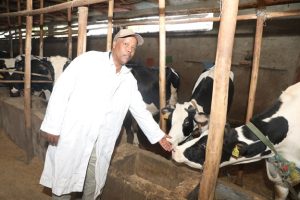BY WOSSENSEGED ASSEFA
Dams have been used to ensure an adequate supply of water since the dawn of human civilization, almost 5000 years ago, by storing water in times of surplus and releasing it in times of lack, thereby mitigating or minimizing floods and actively contributing to the efficient management of limited water supplies that are unevenly distributed and subject to major seasonal fluctuations. Accordingly, in 2011 Ethiopia embarked upon a great project that would affect its economic and political sphere till current times and will do so for the coming years.
The project was The Grand Ethiopian Renaissance Dam (GERD) being built on the Blue Nile River that originates from Ethiopia and combines with the White Nile to form The Nile River. With an installed capacity of 5150 MW, the dam is expected to annually generate around 15,000GWh of energy. The GERD Reservoir will have a total storage of 74 billion cubic meters (bm3), 59 bm3 of it active, or nearly 1.2 times the average annual flow of the Blue Nile at the dam site. When completed and operational, the GERD will be the largest hydroelectric power generation facility in Africa and the fifth largest in the world.
The immensity of this project is new and has never been tried before in Ethiopia, but more than the size of the project the benefits of the project will be more substantial for the country. The GERD will be affecting the economic sector of Ethiopia from multiple dimensions. It will encompass and influence the three major economic sectors in ways that haven’t been seen before. Additionally, the GERD will also bring solutions to the most common socio-economic problems in the country.
The impact of the GERD on the Ethiopian economy is multi-faceted affecting the country’s major economic sectors such as; the service, agricultural and industrial sectors. A simple example to attest this is the impact the artificial lake, formed after the filling and completion of the dam, has on the economy. The artificial lake is expected to contain 73 bm3 of water covering an area of 1883 km² stretching 246 km upstream. The artificial lake formed by the reservoir will be half the size of the upstream Lake Tana. For starters a lake of this size creates opportunities for investors to invest in building and maintaining tourist hotspots; which in turn can boost the tourism and service sector by providing foreign currency from foreign visitors and by creating jobs. The same artificial lake can also be used for fishery. It’s clear that if there is an enormous supply of fish the necessary manufacturing industries will follow, in turn creating additional job opportunities and ushering a boost for the fishery sector of the Ethiopian economy.
Besides, the impact on the fishery and service sectors this artificial lake will also positively affect irrigation in the area. The water held in the reserves can be sustainably used to irrigate areas around the lake. This will boost the agricultural sector of the country by creating opportunities for local farmers and by creating, formerly non-existing, arable land to grow crops on at a sustainable rate feeding the nation and possibly generating foreign currency from export.
Another one of the major benefits of dams, as we all know, is the generation of hydroelectric power. Dams contribute significantly to the reduction of air pollution by generating renewable hydropower electricity. Hydropower is the most abundant and productive renewable energy resource, accounting for a significant portion of all renewable electric energy generated worldwide.
According to a USAID 2016 report, Ethiopia is endowed with abundant renewable energy resources and has a potential to generate over 60,000 megawatts (MW) of electric power from hydroelectric, wind, solar and geothermal sources, currently it only has approximately 2,300 MW of installed generation capacity to serve a population of over 95 million people. It is clear that the amount of power generated is insufficient to address the nation’s household electrical power need let alone strengthen the industrial sector. Therefore, the amount of power produced when the GERD is completed will help stimulate the industrial sector of the country by providing a stable and reliable source of power for industries. This will also positively affect foreign investment on industries since one of the major questions foreign investors ask before building industries is if there is a reliable source of power to run their industries without having to worry about power shortages or outages. This stimulus to the industrial sector will have many benefits for the country’s economy. For example, the construction of industries will lead to more jobs and more jobs means a stable and growing economy.
However, this does not mean the economic benefits of the dam go to profiting Ethiopia alone. The construction of the dam will have multiple benefits for neighboring countries and countries in the Nile Basin. GERD will support Sudan and Egypt by eliminating up to 86 percent of silt and sedimentation, in addition to providing power to Ethiopia. It will maintain a constant water flow throughout the year, preventing floods in downstream countries.
When the GERD is fully operational, sedimentation in the Blue Nile will be reduced by up to 86 percent. Reduced canal dredging costs could save Sudan around USD 50 million per year, not to mention savings in turbine maintenance and replacement costs, ease of gate service, and so on. Furthermore, the excess power generated by the dam can also be sold to and effectively utilized by neighboring countries like Sudan, Kenya and South Sudan.
The dam’s advantages aren’t just economic; they are also socio-economic. One of the major challenges that our world faces at current times is migration. Migration is often linked to poverty, and it is also influenced by other factors such as youth unemployment. Intraregional displacement is dominated by work-seeking migration, as young people move from one country to another in search of better job opportunities. Two of the major causes for migration can be alleviated by the construction of the GERD.
As seen earlier the GERD can help boost the country’s economy by creating more jobs for the youth, which in turn will decrease the migration rate. In addition to that the long-term effects of the GERD on the Ethiopian economy will help alleviate poverty, again decreasing the migration rate. Nonetheless, this is not beneficial just for Ethiopia since a reduction in the migration rates from Ethiopia means less pressure on European countries facing migration problems such as Italy, France and Germany. On top of that the long term economic and socio-economic benefits could also help alleviate poverty in the Horn which in turn stabilizes the region meaning less migration issues for the European countries to deal with.
It is also known that economic solutions can bring about political solutions because economic development and political stability are inextricably linked. On one hand, the instability that comes with an unsteady political climate can deter investment and slow economic growth. Poor economic performance, on the other hand, could result in government collapse and political unrest. Therefore, the long-term economic benefit of the GERD could potentially help solve political problems the country is facing at the moment.
Although the primary goal of the GERD is to produce electricity with an annual energy output of 15000GWh to meet Ethiopia’s and East Africa’s power needs its clear the benefits go far beyond electrical power generation only. The GERD can and will facilitate the economic growth of our country, it will bring about solutions to some of our major socio-economic issues like migration and poverty and it will promote and sustain long-term economic stability in Ethiopia and the Horn. Overall, the importance and benefits that GERD can provide to our people and country are enormous and highly efficient. It will help the country progress economically, socially and politically, helping Ethiopia achieve its goals and agendas within the prescribed time frame. Others may say Nile is the air they breathe; we on the other hand say Abay is the lung we breathe by.
Editor’s Note: The views entertained in this article do not necessarily reflect the stance of The Ethiopian Herald.
The Ethiopian Herald 20 April 2021


